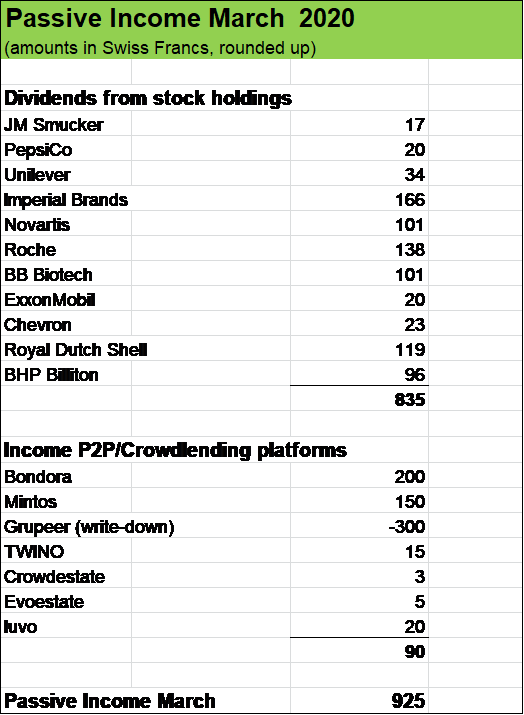This is a guest post.
Bob Ciura over at Sure Dividend reached out to me recently about sharing a guest post here. I am a big fan of the site Sure Dividend which is dedicated to finding high quality dividend growth stocks suitable for long-term investment. In his guest post, Bob presents three strong companies which are also likely to wheather the global recession due to the COVID-19 pandemic.
The recent stock market turmoil has been painful for many investors. Companies with long histories of successful results have seen their share prices decimated and along with it, investor wealth. However, dividend investors will find the current environment full of buying opportunities. The key is to find stocks with long histories of raising dividends, and companies with pedigrees that prove they will hold up in recessionary environments.
We believe investors should focus on stocks that have raised their dividends for at least 10 years in a row, and have high dividend yields above the S&P 500 Index average. In our view, blue-chip dividend stocks are the best bets in times of economic uncertainty.
Below, we’ve selected three such stocks that we believe will continue to provide rising passive income to shareholders through this tough economic period, and beyond.
Rising Passive Income Stock: United Parcel Service
The first stock in our list of those best suited for rising passive income over time is United Parcel Service (UPS), better known as UPS. The company is the global leader in logistics services and packaged delivery, offering various long-distance delivery options. The company was founded in 1907 is split into domestic, international, and supply chain segments. UPS produces more than $75 billion in annual revenue and trades with a market capitalization of $80 billion.
As the global leader in its field, UPS offers unique scale advantages, which should allow it to hold up fairly well during the COVID-19 downturn. The company’s revenue is dependent upon economic activity, but the continued rise of e-commerce means consumers are having ever-rising volumes of goods shipped to their homes; UPS is a direct beneficiary of this. We note that recessionary periods tend to see UPS’ earnings decline, but its strong dividend history means the payout will almost certainly continue to rise.
UPS has continuously paid dividends to shareholders for nearly half a century, and its dividend increase streak currently stands at over 10 years. The company’s dividend increase streak includes the dot-com bubble recessionary period, as well as the financial crisis. Both were significant negative events for the economy at large, and while earnings declined, the company’s dividend continued to be raised. We believe UPS is well positioned to continue this streak for the long-term, given its fundamentals and relatively low payout ratio.
We see the dividend payout rising from the current level of $4.04 annually to $5.35 by 2025, which is on par with its historical dividend growth rate in the mid-single-digits. The payout ratio is just over 50% on this year’s earnings estimates, so even if there is a downturn in the company’s earnings power temporarily due to a recession, there is plenty of financial flexibility to continue to raise the payout. Thus, UPS stands out as a strong pick for those seeking rising passive income over time, and the current dividend yield of 4.3% is quite high as well.
Rising Passive Income Stock: Coca-Cola
The next stock in our list is Coca-Cola (KO), the worldwide leader in cold beverages. The company’s footprint is enormous given it sells its products in nearly every country around the world, and its products amount to just over two billion servings globally every day. Coca-Cola’s product mix has diversified immensely in recent years thanks to internal development, as well as strategic acquisitions. Coca-Cola’s products tend to be seen as affordable luxuries during times of economic duress, and as a result, its earnings hold up very well during such periods. The company has a market capitalization of $190 billion, and produces about $37 billion in annual revenue.
Coca-Cola has a world class dividend history, having raised its payout for 57 consecutive years. That streak is good enough to land it on the highly prestigious list of Dividend Kings, a group of just 30 stocks that have at least 50 consecutive years of dividend increases.
Unlike most companies, Coca-Cola’s earnings estimates for this year are largely unaffected by the COVID-19 outbreak, and resulting economic weakness. As mentioned, the company’s earnings tend to hold up quite well during recessions, and we don’t expect this one to be any different.
The payout ratio is on the higher end at 78%, but Coca-Cola generates significant cash that it doesn’t need to run its business. We therefore believe the payout is not only safe, but that it will continue to rise for years to come. We think the dividend will rise from the current payout of $1.64 per share to $2.14 in the next five years thanks to its long history of increasing the payout in the mid-single-digits annually. We don’t think the current environment will see Coca-Cola stray from this as earnings should remain intact.
Although Coca-Cola’s payout ratio is somewhat higher than other large dividend stocks, its decades-long history of raising the payout through all kinds of economic environments proves it has staying power, and that investors can count on it for rising passive income over time.
Rising Passive Income Stock: Clorox
The third and final stock in our list is Clorox (CLX), the manufacturer and marketer of ubiquitous consumer products such as its namesake bleach and other cleaning products, as well as food and kitchen consumables. Clorox has been around since 1913 and derives more than 80% of its revenue from products that are either first or second in market share. Clorox generates more than $6 billion in annual revenue, and has a current market capitalization of $22 billion.
Clorox also has a very long streak of dividend increases, posting 42 consecutive years of rising income. While it hasn’t quite reached the level of Coca-Cola, Clorox is still a member of the Dividend Aristocrats, a group of just 64 stocks that have at least 25 consecutive years of dividend increases.
Unlike most companies that are grappling with how to cope and survive the COVID-19 crisis, Clorox is a strong beneficiary of the recent lockdown measures. Clorox makes many of the products that are now in extremely high demand, such as various cleaning products, sanitizing wipes, and others. Thus, Clorox should not only survive this downturn, but thrive. As such, earnings-per-share estimates have actually risen for Clorox since the crisis worsened, and we now expect about $6.40 for this year.
The payout ratio for 2020 is currently 66%, so Clorox continues to have ample room to boost the payout. This is particularly true since its earnings are benefiting from COVID-19. Now more than ever, Clorox is well positioned to produce rising passive income for shareholders.
Final Thoughts
While the current outbreak of COVID-19 threatens to derail the global economy into a recession, it has created opportunities for long-term income investors that want to generate rising passive income over time. We believe UPS, Coca-Cola, and Clorox are three such stocks that will continue their long histories of dividend increases to investors through this crisis, and for many years to come.
Disclaimer
You are responsible for your own investment and financial decisions. This article is not, and should not be regarded as investment advice or as a recommendation regarding any particular security or course of action.

